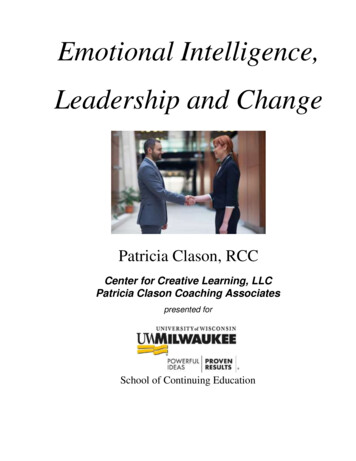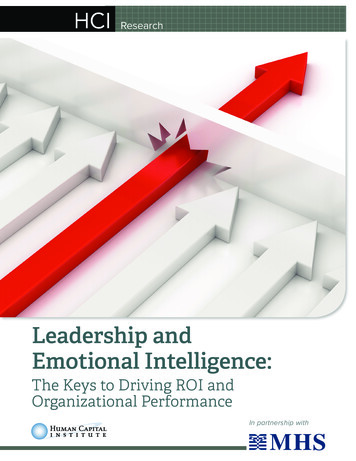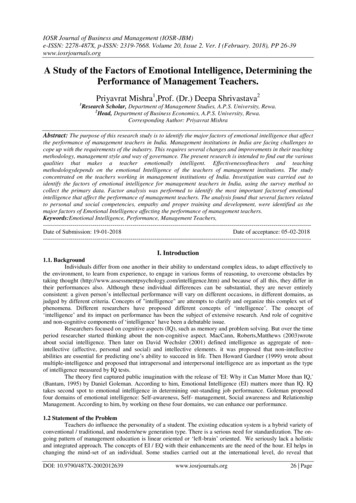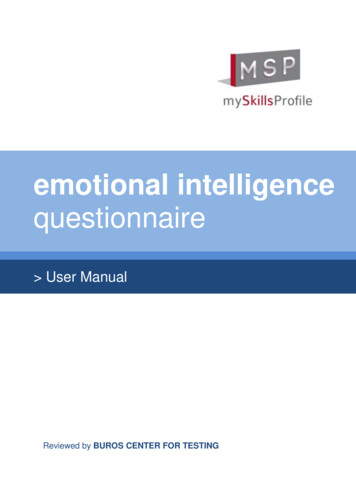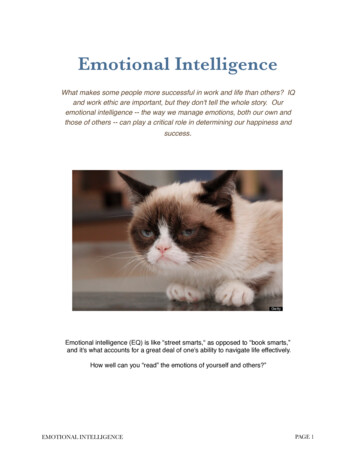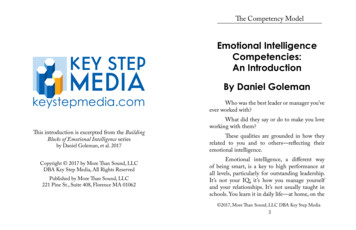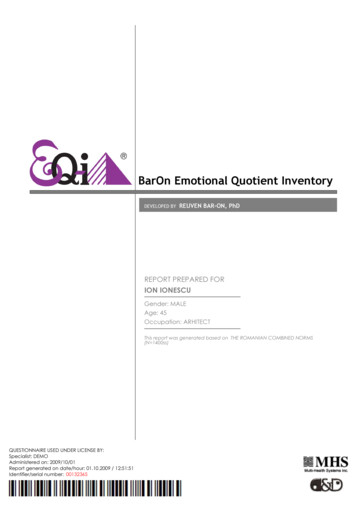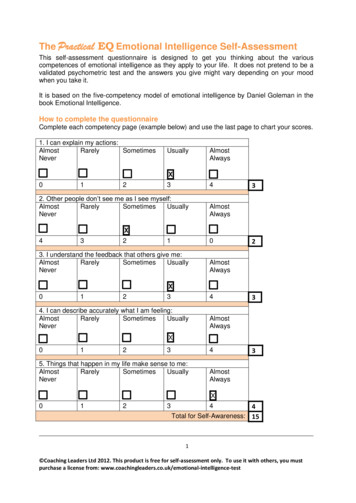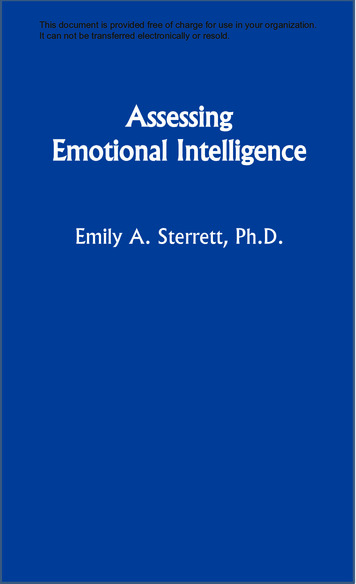
Transcription
EMOTIONAL INTELLIGENCE:The Three Major Theories in the FieldBachelor Degree Project in Cognitive NeuroscienceG2E15 ECTSSpring term 2011Maria HultinSupervisor: Daniel BromanExaminer: Judith Annett
Emotional Intelligence: The Three Major Theories in the FieldSubmitted by Maria Hultin to the University of Skövde as a final year project towards thedegree of B.Sc. in the School of Humanities and Informatics. The project has been supervisedby Daniel Broman.2011-06-06I hereby certify that all material in this final year project which is not my own work has beenidentified and that no work is included for which a degree has already been conferred on me.Signature:
3AbstractEmotional intelligence (EI) is a term that has several definitions and theories. Three majorviews in the field of EI will be presented and discussed in this thesis, furthermore somepractical implications for the research. There will also be a brief overview of the two fields ofemotion and intelligence research, from where the concept of EI has emerged. The first viewpresented is Mayer and Salovey‟s four-branch model of EI, measured with the MayerSalovey-Caruso Emotional Intelligence Test (the MSCEIT). The second view is the Bar-Onmodel of emotional-social intelligence, closely related to the Emotional Quotient Inventory(the EQ-i). The third view is Goleman and colleagues‟ model of EI, which is measured withthe Emotional Competence Inventory (the ECI). These different views of EI will be discussedin terms of ability-models and mixed-models, where the first model presented is referred to asan ability-model of EI and the following two models are seen as mixed-models of EI.Keywords: Emotion, intelligence, emotional intelligence, MSCEIT, EmotionalCompetence Inventory (ECI), Emotional Quotient Inventory (EQ-i)
4Table of nt concepts of intelligenceSpearman‟s two-factor theory.99Thurstone and the primary mental abilities.10The Cattel-Horn-Carroll (CHC) theory.10Gardner and the theory of multiple intelligences.11Sternberg and the triarchic theory of intelligence.12Factor analysisEmotions1313Defining emotion13Different concepts of emotion14Basic emotions.14The circumplex model of affect.14The approach-withdrawal distinction.15History of emotion researchMayer and Salovey‟s view of emotional intelligence1616The view‟s definition of emotional intelligence18The four-branch model19Measuring emotional intelligence22Practical implications for this model25Bar On‟s view of emotional intelligenceThe view‟s definition of emotional intelligence2828
5The Emotional Quotient Inventory (EQ-i)28The Bar-On model of emotional-social intelligence32Practical implications for this model33Goleman‟s view of emotional intelligence35The view‟s definition of emotional intelligence37The Emotional Competence Inventory (ECI)37Goleman‟s model of emotional intelligence40Practical implications for this model41A comparison of the three views42Discussion49Ability-models versus mixed-models of emotional intelligence49Strengths and weaknesses in the three major views of emotional intelligence50Mayer and Salovey‟s view of emotional intelligence.50Bar-On‟s view of emotional intelligence.51Goleman‟s view of emotional intelligence.53Overarching reflections and conclusionsReferences5558
6IntroductionThere are different views of what emotional intelligence (EI) is and how it should bedefined. According to Fernández-Berrocal and Extremera (2006) there are especially threetheories in the field of EI that are accepted in the scientific community. This work focuses onthese three major views and the aim of this thesis is to explain these different views of EI.Furthermore, present some of the strengths and weaknesses of the three views of EI.Emotional intelligence is a growing field of research and since the term „emotionalintelligence‟ has become very popular for the public it is important to point out that there isnot just one clear definition. All three views have their different definitions, theoreticalmodels and different ways to measure emotional intelligence and this work will go throughthem one by one. In addition it will also look at some of the practical implications for theresearch of EI, from the perspectives of the three views. Furthermore, this work also focuseson studies, reviews and meta-analyses in the field in order to compare the different views ofEI. Lastly there will be a discussion, which includes the strengths and weaknesses of the threeviews. Since emotional intelligence relates to the more established research fields of emotionand intelligence, this work starts with a brief overview around some of the theories in thesefields. This overview also provides readers without deeper knowledge in these fields withsome background and historical understanding for the areas that the concept of EI hasemerged from.The different views of EI are often divided into ability-models and mixed-models,based on what they believe are included in the concept of EI. The first approach presenteddefines emotional intelligence as consisting of mental abilities and it falls under the abilitymodels approach. The predecessors of this view are Peter Salovey and John Mayer withcolleagues. They presented the first definition of emotional intelligence (Mayer & Salovey,1990) and based on this definition, a model of emotional intelligence was created. Their
7model is often referred to as the four-branch model of EI. Following this model a performancetest (i.e., an ability test) was developed for measuring the four branches in their model. Thelatest version of this test is called the Mayer-Salovey-Caruso Emotional Intelligence TestVersion 2.0 (MSCEIT V2.0) (Mayer, Salovey, Caruso, & Sitarenios, 2003).The second view that will be addressed is the one from Reuven Bar-On. This viewfalls under the mixed-models approach, because it is said to use a wider definition of EI,mixing mental abilities with personality constructs and competencies (Mayer, Salovey, &Caruso, 2000). Bar-On uses a self-report measure, called the Emotional Quotient Inventory(the EQ-i), to measure emotionally and socially intelligent behavior. From using this test hehas come up with a model, which he refers to as the Bar-On Model of Emotional-SocialIntelligence (ESI) (Bar-On, 2000).The third view is from Daniel Goleman. Goleman wrote a book, EmotionalIntelligence, in 1995, where he popularized the concept of emotional intelligence. This bookwas a bestseller and Goleman‟s ideas of how to define EI became the most known for thepublic. This model is based on the first definition of EI that Mayer and Salovey made 1990. InGoleman‟s popular book, he changed Mayer and Salovey‟s definition somewhat and addeddifferent skills and characteristics into his own concept, and this became a new and differentmodel of EI. Goleman‟s model of EI is also known as a mixed-model (Goleman, 1995). Formeasuring Goleman‟s model a multirater measure was developed. This measure passes underthe name of the Emotional Competence Inventory (ECI) (Sala, 2002).Intelligence“Individuals differ from one another in their ability to understand complex ideas, toadapt effectively to the environment, to learn from experience, to engage in various forms ofreasoning, to overcome obstacles by taking thought.” (Neisser et al., 1996, p. 77). Differentconcepts of intelligence try to explain and organize this complex set of phenomena.
8Intelligence is one of the most researched areas in psychology, but there is not one unifiedview of how it should be defined and measured. There are as many definitions as there areexperts who will define it (Neisser et al., 1996).There are two things that experts seem to agree upon to be present in intelligence.Intelligence has to do with the capacity to learn from experience, and the capacity to adapt toone‟s environment. When asking laypersons to define intelligence and to present what typesof behaviors are typical for an intelligent person, the answers are pretty similar to those we getfrom experts. The common view is that verbal ability and problem-solving are important partsof intelligence (Gregory, 2007). When looking at traditional intelligence tests they ofteninclude measures for these two types of abilities (Williams, McIntosh, Dixon, Newton, &Youman, 2010; Canivez & Watkins, 2010). There are also some differences in laypersons‟and experts‟ views of intelligence. Laypersons believe that social competence is important foran intelligent person, whereas experts points at practical intelligence. Practical intelligencemeans how the person can determine how to achieve goals, if the person displays awarenessof the world and shows interest in the world. The social competence is more about relationswith others, how well the person accepts others for what they are, how punctual they are andif they can admit mistakes. These two parts of intelligence are generally not measured inintelligence tests, partly because it is difficult to make tests for measuring these abilities, butalso because many test developers have accepted the incomplete conceptions of intelligencefrom history and just followed in those tracks, not taking into account these two parts ofintelligence. Now new tests start to evolve that measure practical intelligence (Gregory,2007), and the concept of social competence relates to the development of theories aboutemotional intelligence.
9Different concepts of intelligenceIt is important to look at the history of intelligence theories, if we want to understandthe structure and content of intelligence tests (IQ tests), and the import of intelligence. Also ifwe want to be able to judge the validity of different IQ tests the theories are important.Therefore, some of the most important ones, among all the numerous intelligence theories,will be addressed.The dominant approach in intelligence research is the so called Psychometricapproach. It means that intelligence is something that can be measured using differentpsychometric tests. The use of psychometric instruments for measuring different things iswidely used in Europe and America, for example to make diagnoses and evaluations. Fromthe beginning, many of the tests that exist are not intended to measure intelligence itself, butother related abilities, like scholastic aptitude and school achievement. These tests are oftenused for selection purposes, for example the Scholastic Aptitude Test (SAT) is much used inthe US to be admitted to college (Neisser et al., 1996).The first three theories presented below fall under the notion of the psychometricapproaches, and the two last ones have different views of how intelligence could be measured.Spearman’s two-factor theory. Maltby, Day, and Macaskill (2010) summarizeCharles Spearman‟s contribution in the intelligence research. They mean that Spearmanbelieved it to be two types of factors that constitute intelligence and thereby determinedperformance. The first factor of intelligence consists of specific abilities (s), there existseveral specific abilities s1, s2, s3 sn. For example vocabulary intelligence is a specificability, and mathematical and spatial intelligence are two other specific abilities. Thesespecific abilities are thought to be measured in different amounts in different tests formeasuring intellectual ability. This is shown by low correlations between different tests. Thesecond factor is general intelligence (g), which is seen as a mental energy underlying all the
10other specific abilities. When comparing different tests and high correlations are found thisindicate that the tests measure large amounts of general intelligence. Spearman among othersdeveloped methods of factor analysis for studying these factors (Maltby et al., 2010).Thurstone and the primary mental abilities. When Thurstone saw strongcorrelations between tests, he meant that these could be best explained by several broad groupfactors and not just one single general factor. He proposed seven factors that have beensupported several times. They are called the primary mental abilities (PMAs) and theyinclude: verbal comprehension, word fluency, number, space, associative memory, perceptualspeed and inductive reasoning. He designed tests that were supposed to measure the differentPMAs separately, but his tests had moderate correlations with each other and he recognizedthat there could be a general factor existing as a higher-order factor (Gregory, 2007).The Cattel-Horn-Carroll (CHC) theory. McGrew (2009) referred to the CattelHorn-Carroll theory (CHC) as an umbrella term, which included two closely related wellknown models of intelligence. This theory includes different abilities organized in ahierarchical order. There are three levels, called stratum levels, in this theory. At the highestlevel stratum III, there is a general factor g that is above all cognitive abilities. The next levelis called stratum II, which includes several broad abilities. Exactly how many abilities shouldbe included in this level seems to change, but according to McGrew (2009) there are sixteenbroad abilities (e.g., fluid reasoning, visual processing, quantitative knowledge, and tactileabilities). Under this comes stratum I, which includes many narrower abilities, and thenumber of narrow abilities are also changing, but there are over 8o narrow abilities describedby McGrew (2009). Under for example the broad ability of fluid reasoning comes the fivenarrow abilities of: general deductive reasoning, induction, quantitative reasoning, Piagetianreasoning, and speed of reasoning. For further description of the broad and narrow abilitiessee e.g., McGrew (2009), which are not being further defined in this thesis.
11An intelligence test used today is called the Stanford–Binet Intelligence Scale, FifthEdition (SB5). This test is based on the CHC-theory of intelligence, and it is claimed tomeasure different cognitive abilities. It gives an overall IQ-score, which indicates it ismeasuring general intelligence. It also gives several sub-scores, which indicates to conform tothe hierarchical order in the CHC-theory (Williams et al., 2010). Furthermore, the WechslerAdult Intelligence Scale–Fourth Edition (WAIS-IV) is a widely used intelligence test claimedto measure general intelligence, which also conforms to the CHC-theory (e.g., Anastasi, 1990;Benson, Hulac, & Kranzler, 2010; Canivez & Watkins, 2010).Gardner and the theory of multiple intelligences. Howard Gardner is critical to thepsychometric approach, and that intelligence is seen as one general intelligence g as manyother theorists agree upon. He approves that the scores on many intelligence tests are stable,and show some kind of achievement quite good, they are good for measuring scholasticpotential and school grades, but tell not much of whether the person will succeed in life.Gardner means that if intelligence is just based on these scores we are ignoring otherimportant aspects of mental abilities, which these tests do not measure. Gardner argues that ifwe want to analyze the cognition, we must consider all human problem-solving and productfashioning skills and not just the ones that can be measured by standardized tests (Gardner,1985).In the book Frames of Mind from 1985, Gardner proposes the idea that there exists“several relatively autonomous human intellectual competences” (Gardner, 1985, p. 8), whichhe refers to as human intelligences. He considers that the exact number of these intelligencesis not yet definite, but the important thing is that there are several intelligences that areequally important for understanding the cognition. He proposes it to be seven intelligences sofar and they are: linguistic, logical-mathematical, musical, spatial, bodily-kinesthetic and twokinds of personal intelligences: interpersonal and intrapersonal intelligences (Gardner, 1985).
12Interpersonal intelligence is about understanding other people: How they work, whatmotivates them and how to cooperate with them. Intrapersonal intelligence is the capacity tounderstand yourself, to make a true model of who you are and to be able to use that model tofunction well in life (Gardner, 1993).Gardner says that in our society we have put the two first intelligences, namelylinguistic and logical-mathematical, as the most important intelligences. Many IQ tests arebased on the verbal and mathematical skills, therefore if you are high in those twointelligences you will probably do well in IQ tests and SATs, and therefore succeed in schooland be able to study at prestigious colleges. He wants to put emphasis on the otherintelligences as well, which he considers are equally important in predicting success outsideof school (Gardner, 1993).Sternberg and the triarchic theory of intelligence. Sternberg is also in favor of theview that intelligence is more than one general ability and that traditional intelligence testsfail to measure all components of intelligence (Gregory, 2007). According to Sternberg‟stheory, there are three basic forms of intelligence namely: analytical intelligence, creativeintelligence and practical intelligence. He has created a test supposed to measure these threeintelligences, which he claims do not measure general intelligence. This test is called theSternberg Triarchic Abilities Test (STAT) (Sternberg, 1993, as described in Koke & Vernon,2003). However, there is research indicating this test is related to general intelligence (Koke& Vernon, 2003).A reflection in order to summarize this brief overview of different theories in relationto emotional intelligence is that some of them clearly open up for a broader perspective ofintelligence i.e., Gardner (1985) and Sternberg, whereas others have a more narrowperspective.
13Factor analysisMany intelligence researchers use factor analysis to validate their theories, and theuse of factor analysis has also been an important tool in the field of EI-research. The goal offactor analysis is to get a simplified description of large and complex data sets (Anastasi,1990). There are two types of factor analysis: confirmatory and exploratory. The confirmatoryfactor analysis is important when researchers want to confirm a theory. The researchers startwith a prediction that something is in a certain way, and then they use the test scores and datatrying to confirm their predictions to be right. With exploratory factor analysis researcherswant to summarize interrelationships between different variables, to explain them in a correctway thus to make a conceptualization (Gregory, 2007). For example, one can build a test thatmeasures many different abilities, and the goal is to find out if there are a smaller set ofcommon underlying abilities, so called factors, behind all these abilities. Factor analysis looksat the correlations of the different abilities, and when there are strong correlations the abilitiescan be said to have something in common, an underlying ability or factor. Hence from thebeginning there may have been 20 different abilities that now can be explained by fourunderlying factors (Anastasi, 1990).EmotionsDefining emotionResearchers have for a long time tried to find a good definition for emotion, but itseems almost impossible to find one general definition. In a study by Izard (2010) around 30researchers were asked six questions concerning emotion. They were asked about thedefinition, activation and the functions of emotion. The results were analyzed to seeconsistency and disagreements between these researchers‟ views of different aspects ofemotion. The conclusion was that no general definition was agreed upon but there was a
14better agreement on the structure, functions and activation of emotion. The researchers werealso quite in agreement with the processes or techniques for emotion regulation (Izard, 2010).Different concepts of emotionBasic emotions. In 1872 Darwin published the article, the expression of the emotionsin man and animals, and with this article started the research on facial expressions of humanemotions. Darwin had collected data from different cultures and he proposed that humanemotions are universal and are being expressed in similar ways across cultures. He meant thatthere were evolutionary reasons for these emotions and therefore they were the same and notculturally dependent (Keltner & Ekman, 2000).Since the time of Darwin several researchers have continued this line of research andseveral studies have been made confirming that some human emotions seem to be universaland can be recognized with facial expressions across cultures. In these studies people fromdifferent cultures are asked to report which emotions they believe are being shown in picturesof different facial expressions. There seems to be six emotional facial expressions, whichpeople recognize and display similar in many cultures. Ekman refers to these emotions asbasic human emotions and they are: anger, disgust, fear, happiness, sadness and surprise.These basic emotions are seen as discrete emotions (Ekman, Sorenson, & Friesen, 1969;Ekman & Friesen, 1971; Izard, 1994).The circumplex model of affect. In contrast to the basic emotions, Russell (1980)proposes that there are different dimensions of affect for example pleasure, distress,depression and excitement. According to Russell these dimensions can be described as beinginterrelated and not independent of each other. In his circumplex model of affect he displaysthe different affective states as a circle in a two-dimensional bipolar space (Russell, 1980). Onthe horizontal axis there is a continuum going from unpleasant to pleasant. The vertical axisrepresents level of arousal, going from activation to deactivation (Russell & Feldman Barrett,
151999). This is a dimensional approach of emotion, trying to put the emotions on scales insteadof calling them discrete units (Smith & Kosslyn, 2007).The approach-withdrawal distinction. This is another dimensional approachputting emotions on a dimension of motivation. Researchers suggest it to be two categories ofemotions guiding different behaviors: approach and withdrawal. Approach emotions make theperson want to approach a stimulus and they are suggested to be connected with positiveaffect (PA) (e.g., happiness, and surprise) but there are not only positive affect that areconnected with approach emotions, anger for example is also seen as an approach emotionsince it also makes a person want to approach a stimuli. The opposite emotions are calledwithdrawal emotions, because they evoke the wish to withdraw from a stimulus or situation.These emotions are suggested to be related to negative affect (NA), example of theseemotions are fear, sadness and guilt (Smith & Kosslyn, 2007).Davidson, Jackson, and Kalin (2000) proposed there to be an asymmetry in left andright cerebral activity connected with these approach and withdrawal emotions, whichaccording to them could be seen by measuring PA and NA. They point to several studiesindicating approach-related positive emotions to be connected with higher left cerebralactivity, and the withdrawal-related negative emotions to be connected with more rightcerebral activity (Davidson et al., 2000).In a study by Tomarken, Davidson, Wheeler, and Doss (1992) the general version ofthe Positive and Negative Affect Schedule (the PANAS-GEN) was used to find out theamount of positive and negative affect the participants felt in general, and EEG to measurebrain activity in their resting state. It was indicated to be an asymmetry in the anterior frontalpart of the brain. People who rated themselves as having more approach emotions, such asattentiveness and enthusiasm, which were showed by more positive affect (PA) in thePANAS, were correlated with a higher activity in the left anterior part of the brain when they
16were at rest. The opposite correlation were found for people who rated themselves as havingmore withdrawal emotions such as guilt and fear, as seen by more negative affect (NA) in thePANAS. They showed a higher activity in the right anterior frontal region of the brain. Tosummarize, this study indicates relations between positive affect and activity in the left partsof the brain, as well as relations between negative affect and activity in the right parts of thebrain (Tomarken et al., 1992).History of emotion researchSmith and Kosslyn (2007) suggest that for a long time researchers believed thatemotion and cognition were separate and worked independently of each other. This ideaoriginally came from the ancient Greek where Plato, a philosopher, believed humans hadthree souls; the intellect, the will, and the emotions. These thoughts started debates about therelations between emotion and cognition. Today researchers cannot deny emotion andcognition being interdependent. The greatest impact, for the understanding of the relationsbetween emotion and cognition, came from the understanding of the neural systemsunderlying emotion. An example of an important finding is the amygdala, which is a structurein the brain important for the processing of emotional stimuli. There are different neuralsystems specialized for emotions but these systems are both influenced by and influencessystems for cognition. Researchers mean that there is not a good idea to just study one ofthem without bearing in mind the other since they influence each other (Smith & Kosslyn,2007). This actually suggests that emotions and different cognitive functions (such as memoryand problem-solving) are entwined also on a much more basic level than the concepts that canbe related to emotional intelligence.Mayer and Salovey’s view of emotional intelligenceA review article from 1990 by Salovey and Mayer first talks about emotions and thedebate on whether emotions are adaptive or maladaptive. Then the article reviews the area of
17intelligence research and focus on social intelligence, which was found interesting for theconcept of emotional intelligence. It was in this article the first well known definition ofemotional intelligence was made (Salovey & Mayer, 1990).Salovey and Mayer declare that many researchers have seen emotions to besomething disrupting thought and something having to be controlled for to think clearly. Theother view on emotions talks about them as being an organizing response, which helps todirect attention to important things, and also to motivate action. Salovey and Mayer state thatthey view emotions as organized responses, which typically arise in connection with aninternal or an external event, and which are being judged to be positive or negative for theindividual. They also state that they view emotions as adaptive for the individual and thesecan help to change the personal and social interactions into enriching experience (Salovey &Mayer, 1990).Salovey and Mayer want to distinguish between intelligence per se and models ofintelligence. They indicate intelligence per se being seen as a broad set of mental abilities,which can be defined in different ways, for example Wechsler‟s definition, which is a broadone: “intelligence is the aggregate or global capacity of the individual to act purposefully, tothink rationally, and to deal effectively with his environment” (Wechsler, 1958, as cited inSalovey & Mayer, 1990, p. 186). However, as previously presented there are also differentmodels of intelligence which are seen as more limiting organizations of the field. Mayer andSalovey view for example Spearman‟s g model as a model of intelligence, stating all mentalabilities being intercorrelated. According to Salovey and Mayer‟s statements, in this review,EI may be correlated with other intelligences and conform to the g model or it may not. Theimportant thing they want to assert is that EI could be seen as an intelligence, since it fallsunder the broad definition of intelligence that for example Wechsler had made (Salovey &Mayer, 1990).
18The view’s definition of emotional intelligenceSalovey and Mayer (1990) state the concept of social intelligence having a longhistory among intelligence researchers and that Thorndike distinguished social intelligencefrom other intelligences. Already 1920, Thorndike defined social intelligence as being: “theability to perceive one‟s own and others‟ internal states, motives, and behaviors, and to acttoward them optimally on the basis of that information” (Salovey & Mayer, 1990, p. 187).According to Salovey and Mayer (1990) the concept of social intelligence was difficult tomeasure and some researchers meant that there was no use to consider it, at least not beforesomeone could find better ways measuring it. Salovey and Mayer liked the idea of a socialintelligence and they see the term EI as a subset of social intelligence. They also state theirconcept of EI being part of Gardner‟s view of social intelligence (Salovey & Mayer, 1990),which Gardner refers to as personal intelligences (i.e., inter- and intrapersonal intelligences)(Gardner, 1985). Salovey and Mayer‟s first definition of emotional intelligence includes bothinterpersonal- and intrapersonal skills: “The ability to monitor one‟s own and others‟ feelingsand emotions, to discriminate among them and to use this information to guide one‟s thinkingand actions”(Salovey & Mayer, 1990, p. 189).In later works Salovey and Mayer have refined their definition and made it morespecific, this is a later one:Emotional intelligence involves the ability to perceive accurately, appraise, andexpress emotion; the ability to access and / or generate feelings when they facilitatethought; the ability to understand emotion and emotional knowledge; and the abilityto regulate emotions to promote emotional and intellectual growth (Mayer &Salovey, 1997, p. 10).
19From this definition Mayer and Salovey developed a model to further explain andcontinue to explore the term emotional intelligence. This is the model that will be presentednext and it is called the four-branch model
Bar-On‟s view of emotional intelligence. 51 Goleman‟s view of emotional intelligence. 53 Overarching reflections and conclusions 55 References 58. 6 Introduction There are different views of what emotional intelligence (EI) is and how it should be defined. According to Fernández
